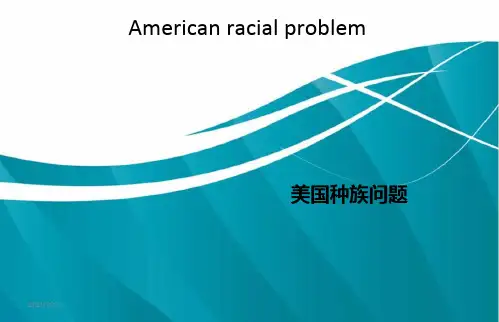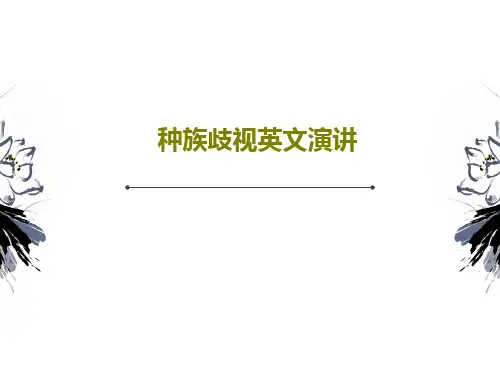种族歧视(英文)课件
- 格式:ppt
- 大小:702.50 KB
- 文档页数:14



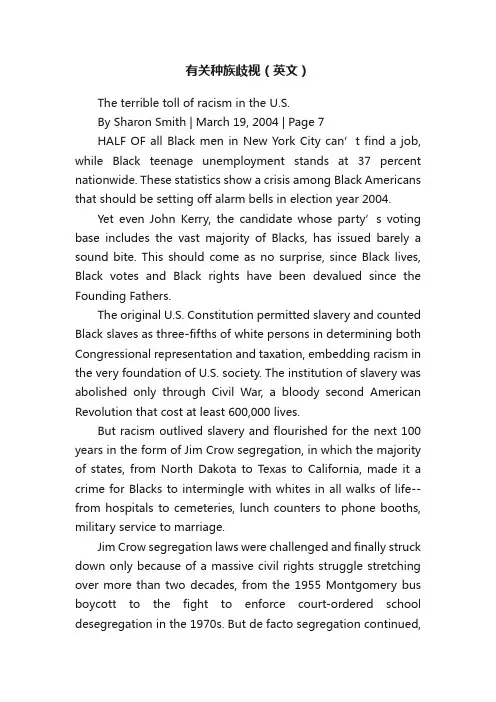
有关种族歧视(英文)The terrible toll of racism in the U.S.By Sharon Smith | March 19, 2004 | Page 7HALF OF all Black men in New York City can’t find a job, while Black teenage unemployment stands at 37 percent nationwide. These statistics show a crisis among Black Americans that should be setting off alarm bells in election year 2004.Yet even John Kerry, the candidate whose party’s voting base includes the vast majority of Blacks, has issued barely a sound bite. This should come as no surprise, since Black lives, Black votes and Black rights have been devalued since the Founding Fathers.The original U.S. Constitution permitted slavery and counted Black slaves as three-fifths of white persons in determining both Congressional representation and taxation, embedding racism in the very foundation of U.S. society. The institution of slavery was abolished only through Civil War, a bloody second American Revolution that cost at least 600,000 lives.But racism outlived slavery and flourished for the next 100 years in the form of Jim Crow segregation, in which the majority of states, from North Dakota to Texas to California, made it a crime for Blacks to intermingle with whites in all walks of life--from hospitals to cemeteries, lunch counters to phone booths, military service to marriage.Jim Crow segregation laws were challenged and finally struck down only because of a massive civil rights struggle stretching over more than two decades, from the 1955 Montgomery bus boycott to the fight to enforce court-ordered school desegregation in the 1970s. But de facto segregation continued,North and South, while accusations of "reverse racism" and Black "welfare dependency" emanated from the political establishment, injecting racism with new life in the post-civil rights era.Politicians from both the Democratic and Republican Parties scrambled to appear "tough on crime," embracing the so-called war on drugs, which tripled the prison population between 1980 and 1995. Two-thirds of those who entered the prison system during that period were Black, Latino or poor, and the vast majority of them were nonviolent drug offenders.Today, with the prison population swollen to more than 2 million, African Americans make up just 12 percent of the U.S. population and only 13 percent of drug users, yet account for 35 percent of drug arrests and 53 percent of drug convictions. Blacks are also 43 percent of those on death row.Last year, the U.S. Bureau of Justice Statistics estimated that 30 percent of 12 year-old Black boys will spend time in jail in their lifetimes--far more than will attend college. And because many states have laws denying present and former inmates the right to vote, an estimated 13 percent of all Black men--including one in every three in Alabama and Florida--have been disenfranchised.Racism, not criminal records, explains the high unemployment rate for Black men today. A recent Wall Street Journal report showed that in the city of Milwaukee, a white job applicant with a criminal record has a better chance of being called for an interview than a Black man with no criminal record."The disadvantage carried by a young Black man applying for a job as a dishwasher or a driver is equivalent to forcing a white man to carry an 18-month prison record on his back," concluded reporter David Wessel. And only racism can explain these statistics:-- Segregation in public schools, which decreased continuously from the 1950s to the late 1980s, has now returned to levels not seen in three decades.-- Black infants are almost two-and-a-half times more likely than white infants to die before the age of one, a wider gap than in 1970.-- In 2002, 79 percent of Blacks aged 25 and older were high school graduates, compared with 30 percent in 1968. Yet the typical Black household had a net worth of just $19,000, compared with $121,000 for whites.More than 200 years since slavery was written into the U.S. constitution, its racist legacy remains--and the words of abolitionist Frederick Douglass remain true: "Without struggle, there can be no progress." Only a struggle that shakes the foundation of U.S. society can end racismRacial discrimination,or,the color problem,refers mainly to Negroes in the United States,as they constitute one tenth of the total population. The term "Negro" is applied to people descended or partly descended from slaves transported from Africa long ago. It is now avoided by many white Americans for fear of offending their "non-white" brothers. The old term "nigger" is now considered to be insulting,and is altogether avoided in decent usage. In official statistics the term "non-white" is used,and in ordinary situations it is acceptable to call non-white people "black",although this term was once also somewhat insulting.种族歧视或肤色问题,在美国主要指与黑人有关的问题,因为他们占美国总人口的十分之一。
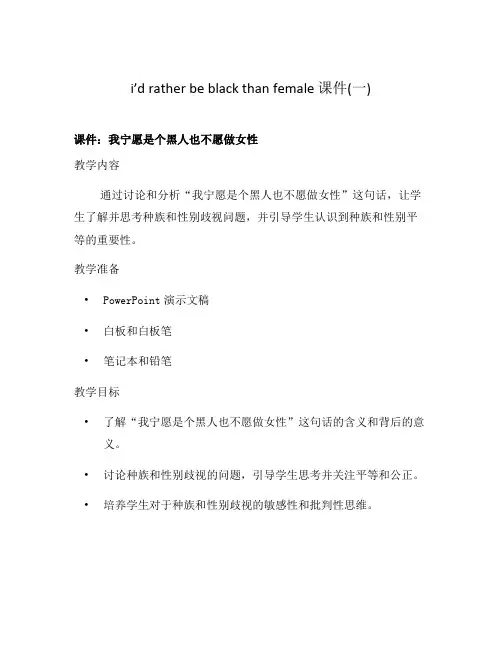
i’d rather be black than female 课件(一)课件:我宁愿是个黑人也不愿做女性教学内容通过讨论和分析“我宁愿是个黑人也不愿做女性”这句话,让学生了解并思考种族和性别歧视问题,并引导学生认识到种族和性别平等的重要性。
教学准备•PowerPoint演示文稿•白板和白板笔•笔记本和铅笔教学目标•了解“我宁愿是个黑人也不愿做女性”这句话的含义和背后的意义。
•讨论种族和性别歧视的问题,引导学生思考并关注平等和公正。
•培养学生对于种族和性别歧视的敏感性和批判性思维。
设计说明这堂课将以小组讨论、案例分析和课堂讨论为主要教学方法,通过引导学生参与思考和讨论,来深化对种族和性别歧视问题的认识。
教学过程1.引入(5分钟)–使用一些图片或视频来引入讨论,展示不同种族和性别的人们在各个领域的成功和贡献。
–提出“我宁愿是个黑人也不愿做女性”这句话,请学生思考其含义,并记录想法。
2.小组讨论(10分钟)–将学生分成小组,让他们分享自己的想法和解读这句话的方式。
–引导学生关注种族和性别歧视在社会中的影响和作用。
3.案例分析(15分钟)–选择几个具体的案例(如历史事件、当代新闻等),展示种族和性别歧视的表现形式,并让学生分析其中的刺激和问题。
–引导学生思考这种种族和性别歧视对个人和社会的影响。
4.课堂讨论(15分钟)–全班一起讨论“我宁愿是个黑人也不愿做女性”这句话的含义和背后的意义。
–引导学生思考并讨论种族和性别歧视的问题。
激发他们对平等和公正的思考。
5.总结和展望(5分钟)–总结课堂讨论的要点,并强调种族和性别平等的重要性。
–鼓励学生在日常生活中对种族和性别歧视持有敏感性和批判性思维。
课后反思•回顾课堂讨论的效果,以及学生对种族和性别歧视问题的认识程度。
•反思教学过程中的不足和可以改进的地方,为今后的教学做出调整。
•准备相关的作业或延伸阅读,让学生继续思考和探讨种族和性别平等的问题。
课后作业•要求学生撰写一篇短文,分享自己对种族和性别平等的理解,以及对解决种族和性别歧视问题的建议。
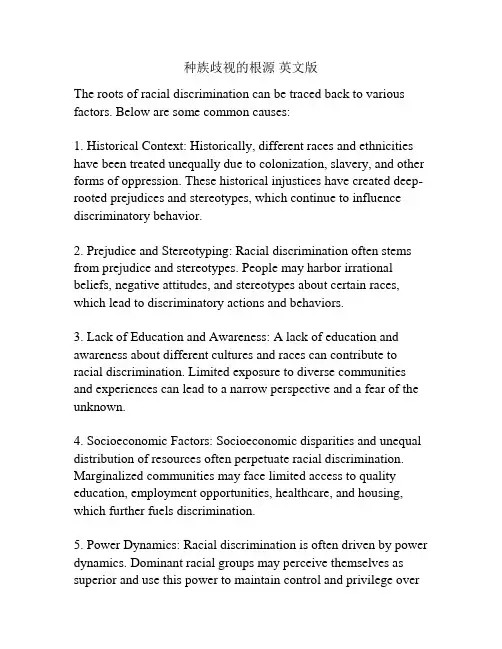
种族歧视的根源英文版The roots of racial discrimination can be traced back to various factors. Below are some common causes:1. Historical Context: Historically, different races and ethnicities have been treated unequally due to colonization, slavery, and other forms of oppression. These historical injustices have created deep-rooted prejudices and stereotypes, which continue to influence discriminatory behavior.2. Prejudice and Stereotyping: Racial discrimination often stems from prejudice and stereotypes. People may harbor irrational beliefs, negative attitudes, and stereotypes about certain races, which lead to discriminatory actions and behaviors.3. Lack of Education and Awareness: A lack of education and awareness about different cultures and races can contribute to racial discrimination. Limited exposure to diverse communities and experiences can lead to a narrow perspective and a fear of the unknown.4. Socioeconomic Factors: Socioeconomic disparities and unequal distribution of resources often perpetuate racial discrimination. Marginalized communities may face limited access to quality education, employment opportunities, healthcare, and housing, which further fuels discrimination.5. Power Dynamics: Racial discrimination is often driven by power dynamics. Dominant racial groups may perceive themselves as superior and use this power to maintain control and privilege overother racial groups.6. Fear and Insecurity: Racial discrimination can also stem from fear and insecurity. Some people may feel threatened by cultural differences and view diversity as a challenge to their own identity or way of life.7. Lack of Legal Protection and Enforcement: Insufficient legal protection and enforcement against racial discrimination may embolden individuals to engage in discriminatory behavior without facing consequences.8. Media Influence: Media plays a significant role in shaping public opinions and attitudes towards different racial groups. Negative portrayals and stereotypes in media can contribute to racial discrimination by reinforcing biases and prejudices.It is important to address the root causes of racial discrimination to foster a more inclusive and equitable society. This can be achieved through education, legal protections, promoting diversity and inclusion, and challenging stereotypes and prejudices.。


